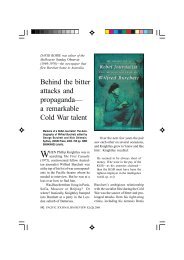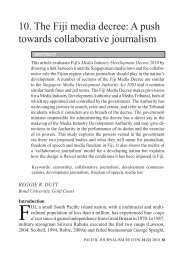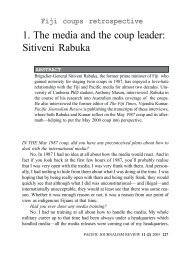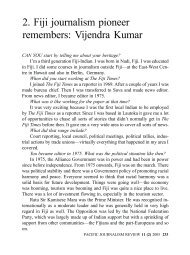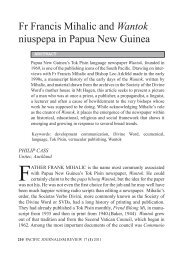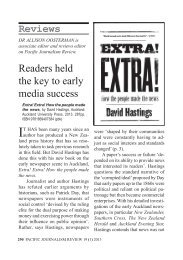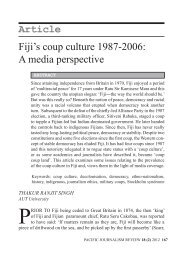1. A case study in ethical failure - Pacific Journalism Review
1. A case study in ethical failure - Pacific Journalism Review
1. A case study in ethical failure - Pacific Journalism Review
You also want an ePaper? Increase the reach of your titles
YUMPU automatically turns print PDFs into web optimized ePapers that Google loves.
MEDIA ETHICS AND ACCOUNTABILITY<br />
portant story. They know that if they do not achieve ‘visibility’, their ‘claims<br />
and concerns’ will not ga<strong>in</strong> recognition (Thompson, 1995, p. 247). Aborig<strong>in</strong>al<br />
people and groups have <strong>in</strong>itiated or been a presence <strong>in</strong> the limited coverage<br />
that the Australian media have devoted to deaths <strong>in</strong> custody. However,<br />
Aborig<strong>in</strong>al spokespeople compla<strong>in</strong> that on many occasions important issues<br />
are missed and that although they try to alert the media to what they regard as<br />
serious issues, they are ignored (Jackson, 2005).<br />
As suggested earlier, nearly 80 percent of Australian journalists, when<br />
surveyed, said that they supported the <strong>in</strong>clusion of the notion of scrut<strong>in</strong>y of<br />
power <strong>in</strong> the role of a journalist. Scrut<strong>in</strong>y of the powerful is particularly important<br />
when those whose lives and well be<strong>in</strong>g are <strong>in</strong>volved are owed a ‘duty<br />
of care’ by the state. This <strong>case</strong> <strong>study</strong> suggests that collectively, Australian<br />
journalists have failed to scrut<strong>in</strong>ise why Aborig<strong>in</strong>al people cont<strong>in</strong>ue to die <strong>in</strong><br />
custody <strong>in</strong> Australia. This is despite the importance attached to the media the<br />
Royal Commission f<strong>in</strong>d<strong>in</strong>gs and by the media’s response <strong>in</strong> 1992. This <strong>failure</strong><br />
<strong>in</strong> accountability does not mean that the media are ma<strong>in</strong>ly responsible for<br />
the deaths but that journalists have contributed by fail<strong>in</strong>g to keep the issue <strong>in</strong><br />
the public sphere by scrut<strong>in</strong>is<strong>in</strong>g those with political, judicial or coercive<br />
power. On many occasions journalists have not even reported newsworthy<br />
comments by judicial officers about the conditions <strong>in</strong> prison. To return to<br />
Curran’s notion of the role of media <strong>in</strong> a democracy, as far as this ‘story’ is<br />
concerned, Australian journalists have not susta<strong>in</strong>ed a ‘vigilant scrut<strong>in</strong>y’ of<br />
government, let alone protected more disadvantaged groups (Curran 2002,<br />
p. 247).<br />
Some journalists may simply respond that the news agenda is always<br />
competitive and responds to the social and political environment of the time.<br />
The difficulty is, of course, that while this may provide an acceptable professional<br />
explanation for some, it provides no answer to the Aborig<strong>in</strong>al community<br />
or to those who support a broader democratic role for the media. Indeed<br />
such explanations may seem rather self-serv<strong>in</strong>g when l<strong>in</strong>ed up aga<strong>in</strong>st the<br />
strong message of commitment implied by the report<strong>in</strong>g of the Royal Commission<br />
report. Indeed, the pattern of coverage might suggest that for Aborg<strong>in</strong>al<br />
deaths <strong>in</strong> custody to make the story list <strong>in</strong> the competitive world of news,<br />
Aborig<strong>in</strong>al communities must riot.<br />
This <strong>case</strong> <strong>study</strong> is just one example of how the media often fail to deliver<br />
coverage of stories that impact on disadvantaged groups (Bacon & Nash,<br />
2003; Bacon & Nash, 2004; Turner, 2005). Such <strong>case</strong> studies can do more<br />
36 PACIFIC JOURNALISM REVIEW 11 (2) 2005



